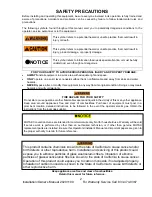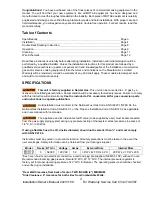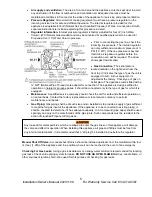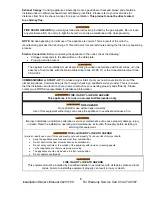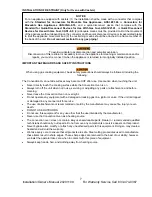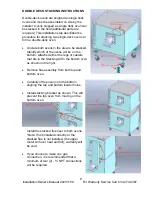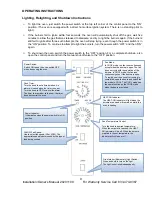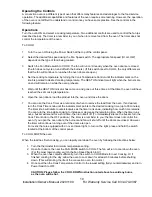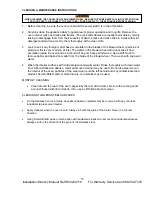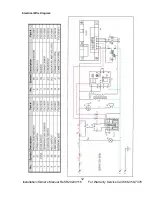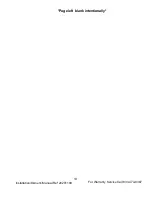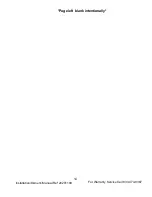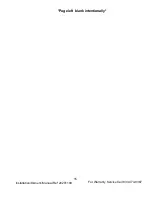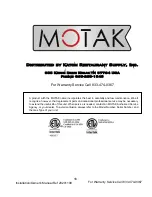
5
Installation/Owner’s Manual 20201109
For Warranty Service Call 833-474-0367
•
Air supply and ventilation:
The area in front and around the appliance must be kept clear to avoid
any obstruction of the flow of combustion and ventilation air. Adequate clearance must be
maintained at all times in front and at the sides of the appliance for servicing and proper ventilation.
•
Pressure Regulator:
All commercial cooking equipment must have a pressure regulator on the
incoming service line for safe and efficient operation. The internal regulator provided for this
appliance is adaptable for both Natural Gas and Liquefied Propane (LP) Gas. A conversion kit with
separate instructions is included explaining this procedure in detail.
•
Regulator information:
Internal p
ressure regulator is factory adjusted for four (4”) inch Water
Column (WC) Natural Gas standard and may be converted by qualified personnel to be used for
Propane at ten (10”) Water Column pressure.
•
Prior to connecting the gas line, check the
incoming line pressure. The internal regulator
can only withstand a maximum pressure of ½
PSI (14” WC). If the line pressure is beyond
this limit, a step down regulator before the
convection oven will be required. The arrow
shows gas flow direction.
•
Gas Connection:
The serial plate is
located outside on the right panel near the
front top. It indicates the type of gas the unit is
equipped to burn. All our equipment is
adjusted at the factory. Check type of gas on
serial plate. The appliance comes fitted with a
¾” NPT (National Pipe Thread) male adapter for connection. The appliance is design-certified for
operation on natural or propane gases, it should be connected only to the type of gas for which it is
equipped.
•
Maintenance
: A qualified service company should check the unit for safe and efficient operation on
an annual basis. Contact the factory representative or local service company to perform
maintenance and repairs.
•
Gas Piping:
Gas piping shall be of such size and so installed as to provide a supply of gas sufficient
to meet the full gas input of the appliance. If the appliance is to be connected to existing piping, it
shall be checked to determine if it has adequate capacity. Joint compound (pipe dope) shall be used
sparingly and only on the male threads of the pipe joints. Such compounds must be resistant to the
action of Liquefied Propane (LPG) gases.
Manual Shut Off Valve:
A manual shut off valve should be installed upstream from the manifold, within four
(4) feet, (1.2M) of the appliance and in a position where it can be reached in the event of an emergency.
Checking For Gas Leaks:
Using a gas leak detector or a soapy water solution is recommended for locating
gas leaks. Check entire piping system for leaks.
DO NOT USE AN OPEN FLAME
Matches, candle flame, or
other sources of ignition shall not be used for this purpose of checking for gas leaks
Any loose dirt or metal particles, which are allowed to enter the gas lines on this appliance, will damage
the valve and affect its operation. When installing this appliance, all pipe and fittings must be free from
any internal contaminates. It is recommended that a “drip leg” be installed in-line before the regulator.


